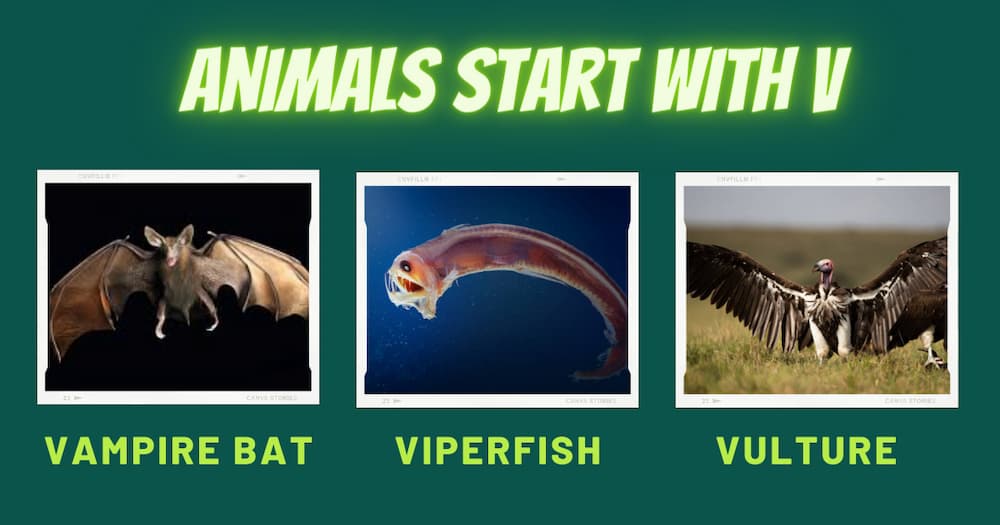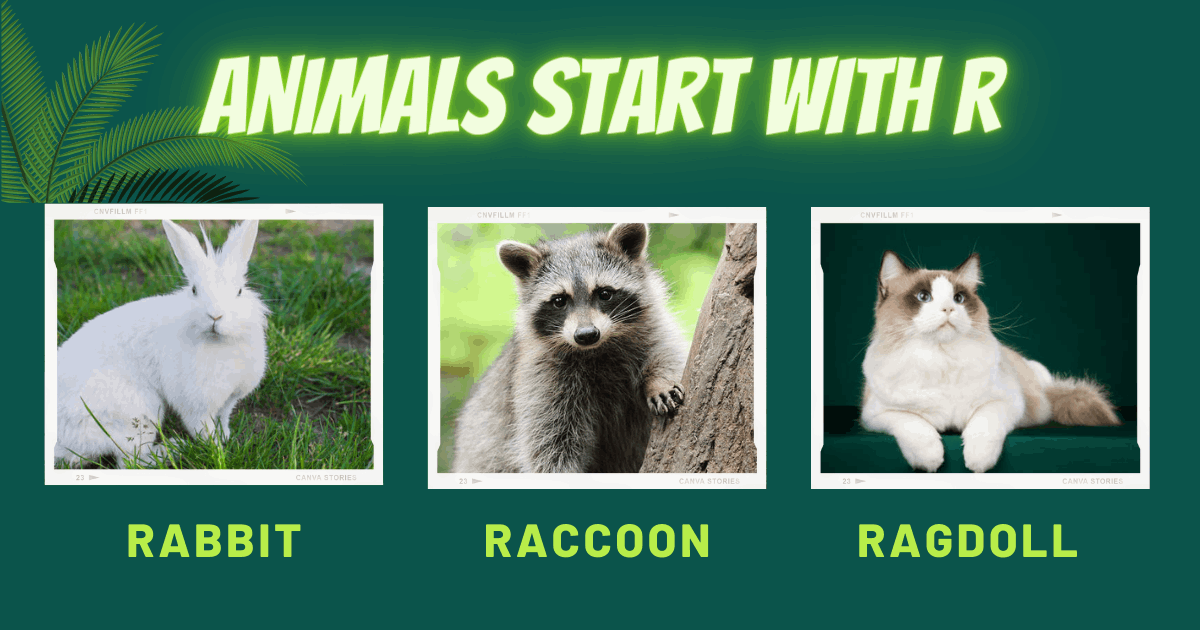Are you curious about the animals that start with the letter V? In this post, we’ve compiled a list of 30 animals that start with V. From Vagrant Shrews to vultures; this list has it all! So, whether you want fun or to learn something new, check out this list!
Alphabetical List of Animals That Start with V
Here is an alphabetical list of some of the world’s most amazing animals, starting with U.
1. Vagrant Shrew:
- The Vagrant Shrew is a small mammal found in various habitats, including forests, grasslands, and wetlands.
- It has a distinctive pointed snout is known for its voracious appetite, consuming insects, small vertebrates, and plant matter.
- Despite its small size, the Vagrant Shrew is an active hunter, relying on its sharp teeth and a strong sense of smell to locate prey.
2. Vampire Bat:
- The Vampire Bat is a fascinating creature known for its unique feeding habits. It primarily feeds on the blood of other animals, often using a specialized heat-sensing system to locate blood vessels beneath the skin.
- Contrary to popular belief, vampire bats do not suck blood; instead, they make small incisions and lap up the blood using their tongues.
- These bats play a crucial role in the ecosystem by regulating populations of other animals and acting as pollinators for certain plant species.
3. Vampire Squid:
- The Vampire Squid is an intriguing deep-sea creature that resides in the oxygen-minimum zones of the ocean.
- It possesses large eyes and bioluminescent organs, allowing it to navigate the dark depths.
- The vampire squid does consume blood; instead, it uses its long, flexible feeding tentacles to capture small prey.
4. Vancouver Island Marmot:
- The Vancouver Island Marmot is the only species of marmot found on Vancouver Island and is a unique part of the island’s natural heritage.
- These adorable rodents are known for their burrowing behavior and hibernation habits.
- Conservation efforts are in progress to preserve and maintain the population of this rare marmot species.
5. Vanikoro Flying Fox:
- The Vanikoro Flying Fox, also known as the Temotu Flying Fox, is a giant fruit bat found in the Solomon Islands.
- With a wingspan of up to one meter, it is an excellent flyer, capable of covering long distances in search of food.
- Unfortunately, the Vanikoro Flying Fox faces habitat loss and hunting threats like many other bat species.
6. Vaquita:
- The Vaquita is the world’s smallest and most endangered cetacean species, with an estimated population of fewer than ten individuals.
- Found in the northern part of the Gulf of California, Mexico, this porpoise is on the brink of extinction due to bycatch in fishing nets.
- Conservation efforts are urgently needed to save the Vaquita from disappearing forever.
7. Variegated Squirrel:
- The Variegated Squirrel is a colorful and agile tree-dwelling rodent native to Central and South America.
- It has a striking coat pattern with shades of brown, black, and white.
- These squirrels are known for their acrobatic skills, quickly leaping from branch to branch.
8. Veiled Chameleon:
- The Veiled Chameleon, also known as the Yemen Chameleon, is a reptile species native to the Arabian Peninsula.
- It possesses remarkable camouflage abilities, changing its skin color to blend with the surroundings.
- This chameleon species is also known for its impressive casque, a bony crest on the head.
9. Velvet Asity:
- The Velvet Asity is a small bird species endemic to the rainforests of Madagascar.
- It showcases stunning plumage, with males displaying vibrant blue and green colors.
- These birds have a unique feeding behavior, utilizing their specialized bill to extract nectar and small insects from flowers.
10. Velociraptor:
- Velociraptor was a genus of small, carnivorous dinosaurs that lived during the Late Cretaceous period.
- Despite its portrayal in popular culture, Velociraptor was not as large as depicted in movies.
- These dinosaurs were swift and intelligent hunters, using their sharp claws and agility to capture prey.
11. Verreaux’s Sifaka:
- Verreaux’s Sifaka, also known as the Dancing Sifaka, is a species of lemur found in Madagascar.
- It is famous for its unique sideways hopping locomotion, which resembles dancing.
- Unfortunately, habitat loss and hunting pose significant threats to the survival of this charismatic lemur.
12. Vervet Monkey:
- The Vervet Monkey is a medium-sized primate species in various parts of Africa.
- It is known for its distinct blue face and vibrant coat, ranging from gray to yellow.
- Vervet Monkeys are highly social animals, living in troops and exhibiting complex social behaviors.
13. Vesper Rat:
- The Vesper Rat, also known as the Cape Vesper Mouse, is a rodent species endemic to South Africa.
- It is primarily nocturnal, emerging to forage for seeds, fruits, and insects at dusk.
- These rats are adaptable and inhabit various habitats, from grasslands to forests.
14. Victoria Collared Lemming:
- The Victoria Collared Lemming is a small rodent species native to North America.
- It is well-adapted to the cold climate, with a dense fur coat and specialized digging claws.
- These lemmings play a vital role in the Arctic ecosystem, serving as prey for predators such as Arctic foxes and owls.
15. Vicuna:
- The Vicuña is a camelid species native to the high-altitude regions of the Andes in South America.
- Known for its incredibly soft and valuable wool, the Vicuña has been hunted to near extinction.
- Conservation efforts and sustainable management of Vicuña populations have helped revive their numbers and protect their habitat.
16. Vine Snake:
- The Vine Snake, also known as the Ahaetulla Snake, is a slender and arboreal reptile found in various regions of Asia.
- With their elongated bodies and green coloration, they are expertly camouflaged among vegetation.
- Vine Snakes are non-venomous and rely on their stealth and lightning-fast strikes to capture prey.
17. Vinogradov’s Jird:
- Vinogradov’s Jird, also known as the Vinogradov’s Gerbil, is a small rodent species native to the desert regions of Kazakhstan and Turkmenistan.
- These jirds are well-adapted to arid environments and can survive long periods without drinking water.
- Vinogradov’s Jirds are social animals, forming burrow systems and displaying complex social behaviors.
18. Viper Shark:
- The Viper Shark, also known as the Trigonognathus kayak, is a deep-sea shark species around Japan and the Philippines.
- It possesses a unique protruding jaw with long, fang-like teeth, earning it the name “Viper Shark.”
- Little is known about the behavior and biology of the Viper Shark due to its deep-sea habitat.
19. Viperfish:
- The Viperfish is a deep-sea fish known for its ferocious appearance and long, needle-like teeth.
- It resides in the ocean’s depths and uses its bioluminescent lure to attract prey in the darkness.
- Viperfish are skilled predators, capable of capturing and consuming fish more significantly than themselves.
20. Vireo:
- Vireos are a group of small to medium-sized songbirds found in the Americas.
- They are known for their melodic songs and are often recognized by their distinctive facial markings.
- Vireos feed on insects and build tree cup-shaped nests to raise their young.
21. Virgin Islands Dwarf Gecko:
- The Virgin Islands Dwarf Gecko, also known as the Sphaerodactylus parthenolide, is a small lizard species endemic to the Virgin Islands in the Caribbean.
- It is one of the smallest gecko species in the world, with adults reaching a length of only a few centimeters.
- The Virgin Islands Dwarf Gecko is primarily nocturnal and has adapted to various habitats, including forests and rocky areas.
22. Virginia Opossum:
- The Virginia Opossum is a marsupial native to North America, known for its unique reproductive strategy.
- Like kangaroos, females carry their young in a pouch until they can survive independently.
- Virginia Opossums are opportunistic omnivores, feeding on various foods, including fruits, insects, and carrion.
23. Visayan Spotted Deer:
- The severely endangered Visayan Spotted Deer, also called the Philippine Spotted Deer, is a type of deer that inhabits the Visayan Islands in the Philippines.
- It is known for its beautiful coat pattern of white spots on a reddish-brown background.
- Habitat loss and hunting have drastically reduced the population of the Visayan Spotted Deer, making conservation efforts crucial for its survival.
24. Visayan Warty Pig:
- The Visayan Warty Pig, also known as the Sus cebifrons, is a critically endangered pig species endemic to the Visayan Islands of the Philippines.
- It is characterized by its distinctive facial warts and bristly coat.
- The Visayan Warty Pig helps significantly with seed dispersal and ecosystem management. Still, habitat degradation and hunting threaten the species’ population.
25. Vlei Rat:
- The Vlei Rat, also known as the Otomys irroratus, is a rodent species in wetland habitats across southern Africa.
- It is well-adapted to its aquatic environment, with partially webbed hind feet for swimming.
- Vlei Rats construct elaborate burrow systems and feed on grasses and aquatic plants.
26. Voalavoanala:
- The Voalavoanala, also known as the Voalavo antsahabensis, is a rare and critically endangered rodent species found only in a small region of Madagascar.
- It is one of the smallest known rodents, measuring less than 10 centimeters long.
- Due to its limited distribution and declining population, the Voalavoanala is a focus of conservation efforts.
27. Volcano Rabbit:
- The Volcano Rabbit, also known as the Romerolagus Diaz, is a small rabbit species native to the high-altitude volcanic regions of Mexico.
- It is well-adapted to its mountainous habitat, with stout legs and dense fur to withstand the cold temperatures.
- The Volcano Rabbit is an herbivorous species, feeding on grasses, herbs, and other plant materials.
28. Vole:
- Voles are small rodents that belong to the Microtus genus and are found in various habitats across the Northern Hemisphere.
- They are known for their burrowing behavior and rapid reproductive rates.
- Voles play critical ecological roles as prey for predators and shape vegetation communities through feeding habits.
29. Volpino Italiano:
- The Volpino Italiano, or the Italian Spitz, is a small dog breed native to Italy.
- It is known for its fluffy white coat, pointed ears, and lively personality.
- Volpino Italiano are loyal and affectionate companions, often forming strong bonds with their owners.
30. Vulture:
- Vultures are large scavenging birds found on every continent except Antarctica.
- They play a crucial ecological role in cleaning up carrion, helping prevent disease spread.
- Vultures have specialized adaptations for their scavenging lifestyle, such as a bald head to prevent feathers from getting soiled while feeding.
Conclusion:
We hope you enjoyed learning about the many fascinating animals that start with the letter V. From the tiny vampire bat to the giant Vanessa butterfly; these creatures come in all shapes and sizes.
What are some of your favorite ones? Drop a comment down below and share them!



